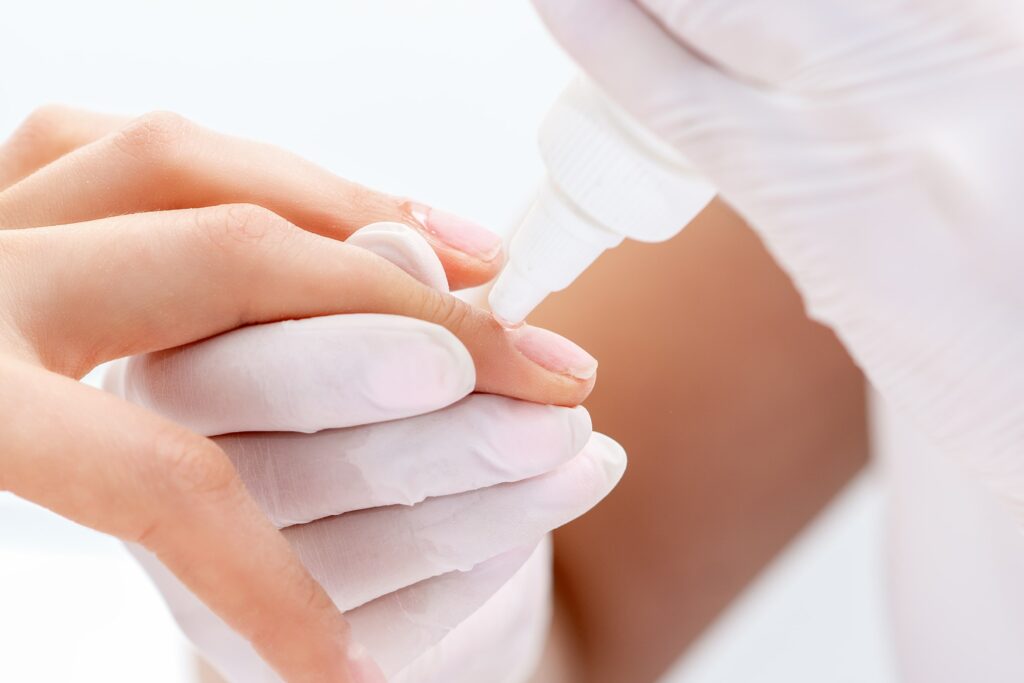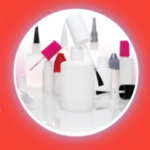
Nail Glue Adhesives: Frequently Asked Questions
Nail glue adhesives are not a one-size-fits-all option. ThreeBond has more than 45 years of experience as a leader in the private label segments of retail nail care products. This means we sell our nail glue adhesives to some of the most well-known and largest cosmetic companies in the world. We are proud of our nail glue adhesives and want our customers to understand the full benefits of choosing ThreeBond as a partner in nail care products.
Cyanoacrylates are a family of strong, fast-acting, clear bonding adhesives with a variety of common uses. Cyanoacrylate glue is derived from ethyl cyanoacrylate and related esters. When cured, the super glue takes the shape of a polymer (plastic) resin that bonds quickly and strongly. When stored properly in cool temperatures and unopened, cyanoacrylate glue has a one-year shelf life. Once opened, cyanoacrylate glue has a much shorter shelf life and must be stored properly and sealed. This varies by manufacturer and specific product type, as well as storage environment.
The typical shelf life of cyanoacrylate glue is hugely dependent on the storage environment. When the glue is stored properly, shelf life can be extended. Refrigeration or cold room storage units are often used to help extend the usable life of unused cyanoacrylate glue. This type of storage will often extend the average shelf life of cyanoacrylate from 12 months to 13-15 months. For open containers, keep the bottles capped and stored at room temperature. Once opened never refrigerate cyanoacrylate glue, as the moisture content will condense prematurely and cure the adhesive. Store all opened containers at room temperature and cap securely to maximize shelf life.
Unlike traditional nail polish, the thickness of cyanoacrylate glue cannot be changed. The fluidity of adhesive is measured in its non-cured state. Cyanoacrylate glue typically has a low viscosity which makes it very fluid. This is why the glue is recommended for small cavities or flat surfaces. More porous surfaces require a high viscosity adhesive, like a gel.
H2: How do I safely remove cyanoacrylate glue from nails?
Cyanoacrylate glue, or nail glue adhesives, are removed with TB Remover 31 or pure acetone. When removing any product from the nail, it’s important to use caution. With a solvent, the cured plastic adhesive will dissolve. Since most solvents recommended for cyanoacrylate are strong, it’s important to use caution so that the solvent doesn’t eat away at the nail when removing the nail glue adhesive.
In general, the cure time of cyanoacrylate nail glue can vary depending on the viscosity of the glue and the thickness of the application. Glues with thinner viscosity, like cyanoacrylate, typically dry faster than a thicker viscosity adhesive, such as a gel. For thicker viscosity nail glue adhesives, an activator can be used to speed up dry time and encourage the adhesive to cure.
Viscosity is a measure of an adhesive’s fluidity. High viscosity adhesives don’t run and are usually a thicker consistency like a gel or cream. Low viscosity adhesives are very fluid and will run when applied. Most cyanoacrylates are low viscosity and best used on flat surfaces that are level. A large range of medium viscosity adhesives exist as well, that are beneficial for porous or uneven surfaces.
By using an activator, the curing time of cyanoacrylate glue can be sped up. This is especially necessary in cold, dry conditions. An all-purpose accelerator is beneficial when quick bonding is needed.
When doing Dip System manicures, it’s best to use a cyanoacrylate glue that will melt the dip powders. Before using a cyanoacrylate, be sure to test compatibility for all dip systems, powers, and activators.
Activators are used to speed up the dry time on an application. Higher viscosity glues typically require a longer curing time, and so an activator can be used to speed up the process for a faster experience. The important thing is to always match the activator with the type of cyanoacrylate being used to avoid drying the adhesive too quickly.
Cyanoacrylate glue has a mild odor associated with the curing process. Low odor cyanoacrylate must be specialty formulated to be extremely low odor. Because of this, it comes at a higher cost and it takes longer for it to set. In general, using cyanoacrylate glue is not very toxic and wears off quickly.
Cyanoacrylate glue can create a white residue during the vaporization process called “blooming.” The white residue can be found in areas that are regularly handled by users. It is common and doesn’t interfere with the bond. However, if you can correctly control temperatures, increase airflow, and reduce humidity, blooming can be reduced. When the glue is packaged, good ventilation is always recommended to prevent the white residue from forming.
Most often, cyanoacrylate glue will not dry shiny. The humidity in the air will often impact the final look of the glue. If you are looking to achieve a shinier finish, using an activator can often help. The goal is to reduce humidity and speed up the curing process to help the glue dry with a shiny finish.
When working with cyanoacrylate it’s common to use a brush to get an even and thin application. While it may be tempting to test out different types of brushes with your nail adhesive glue, it’s best to stick with a nylon brush to ensure the bristles don’t cause an issue during the application or the curing process.
Glass is not the preferred method to store cyanoacrylate glue. Use caution when choosing a glass container, as it can reduce the shelf life of the product. It is best to store nail glue in a resealable container that limits the amount of air and humidity that can get in the bottle. Keeping your cyanoacrylate adhesive in a cool dry place is best to maximize shelf life.
As nail glue adhesive gets closer to the end of its shelf life, you might notice strings start to form when it’s used. You will also likely notice the glue becomes thicker and less runny like it was when it was fresh. Keep in mind the shelf life of nail glue adhesive is only 12 months when unopened and stored properly.
There are applications outside of nail salons where cyanoacrylate glue is used. It is often used in medical settings to close wounds and as other medical type bandaging. This type of cyanoacrylate is higher grade than ethyl cyanoacrylate.
ABOUT THREEBOND
ThreeBond International has over 45 years of experience as a leader in the private label segment of retail nail care products where we provide: adhesives (cyanoacrylate glue), accelerators, enamel removers, and UV nail curators. If you're interested in partnering with ThreeBond, please contact us here: https://threebond.com/contact-us/.
What is the typical shelf life of cyanoacrylate glue?
Cyanoacrylates are a family of strong, fast-acting, clear bonding adhesives with a variety of common uses. Cyanoacrylate glue is derived from ethyl cyanoacrylate and related esters. When cured, the super glue takes the shape of a polymer (plastic) resin that bonds quickly and strongly. When stored properly in cool temperatures and unopened, cyanoacrylate glue has a one-year shelf life. Once opened, cyanoacrylate glue has a much shorter shelf life and must be stored properly and sealed. This varies by manufacturer and specific product type, as well as storage environment.
How can I extend the shelf life of cyanoacrylate glue?
The typical shelf life of cyanoacrylate glue is hugely dependent on the storage environment. When the glue is stored properly, shelf life can be extended. Refrigeration or cold room storage units are often used to help extend the usable life of unused cyanoacrylate glue. This type of storage will often extend the average shelf life of cyanoacrylate from 12 months to 13-15 months. For open containers, keep the bottles capped and stored at room temperature. Once opened never refrigerate cyanoacrylate glue, as the moisture content will condense prematurely and cure the adhesive. Store all opened containers at room temperature and cap securely to maximize shelf life.
Do you sell something that can be added to cyanoacrylate to change the viscosity?
Unlike traditional nail polish, the thickness of cyanoacrylate glue cannot be changed. The fluidity of adhesive is measured in its non-cured state. Cyanoacrylate glue typically has a low viscosity which makes it very fluid. This is why the glue is recommended for small cavities or flat surfaces. More porous surfaces require a high viscosity adhesive, like a gel.
H2: How do I safely remove cyanoacrylate glue from nails?
Cyanoacrylate glue, or nail glue adhesives, are removed with TB Remover 31 or pure acetone. When removing any product from the nail, it’s important to use caution. With a solvent, the cured plastic adhesive will dissolve. Since most solvents recommended for cyanoacrylate are strong, it’s important to use caution so that the solvent doesn’t eat away at the nail when removing the nail glue adhesive.
What is the cure time of cyanoacrylate glue?
In general, the cure time of cyanoacrylate nail glue can vary depending on the viscosity of the glue and the thickness of the application. Glues with thinner viscosity, like cyanoacrylate, typically dry faster than a thicker viscosity adhesive, such as a gel. For thicker viscosity nail glue adhesives, an activator can be used to speed up dry time and encourage the adhesive to cure.
What is the difference between high, medium, and low viscosity?
Viscosity is a measure of an adhesive’s fluidity. High viscosity adhesives don’t run and are usually a thicker consistency like a gel or cream. Low viscosity adhesives are very fluid and will run when applied. Most cyanoacrylates are low viscosity and best used on flat surfaces that are level. A large range of medium viscosity adhesives exist as well, that are beneficial for porous or uneven surfaces.
How do you shorten the set time of cyanoacrylate glue?
By using an activator, the curing time of cyanoacrylate glue can be sped up. This is especially necessary in cold, dry conditions. An all-purpose accelerator is beneficial when quick bonding is needed.
What are the best nail adhesive glues for Dip System?
When doing Dip System manicures, it’s best to use a cyanoacrylate glue that will melt the dip powders. Before using a cyanoacrylate, be sure to test compatibility for all dip systems, powers, and activators.
When do you use an activator with cyanoacrylate glue?
Activators are used to speed up the dry time on an application. Higher viscosity glues typically require a longer curing time, and so an activator can be used to speed up the process for a faster experience. The important thing is to always match the activator with the type of cyanoacrylate being used to avoid drying the adhesive too quickly.
Is cyanoacrylate considered low odor?
Cyanoacrylate glue has a mild odor associated with the curing process. Low odor cyanoacrylate must be specialty formulated to be extremely low odor. Because of this, it comes at a higher cost and it takes longer for it to set. In general, using cyanoacrylate glue is not very toxic and wears off quickly.
Why does cyanoacrylate turn white?
Cyanoacrylate glue can create a white residue during the vaporization process called “blooming.” The white residue can be found in areas that are regularly handled by users. It is common and doesn’t interfere with the bond. However, if you can correctly control temperatures, increase airflow, and reduce humidity, blooming can be reduced. When the glue is packaged, good ventilation is always recommended to prevent the white residue from forming.
Why doesn’t cyanoacrylate stay shiny like a topcoat?
Most often, cyanoacrylate glue will not dry shiny. The humidity in the air will often impact the final look of the glue. If you are looking to achieve a shinier finish, using an activator can often help. The goal is to reduce humidity and speed up the curing process to help the glue dry with a shiny finish.
What are the best brushes to use with cyanoacrylate glue?
When working with cyanoacrylate it’s common to use a brush to get an even and thin application. While it may be tempting to test out different types of brushes with your nail adhesive glue, it’s best to stick with a nylon brush to ensure the bristles don’t cause an issue during the application or the curing process.
Can you use a glass package with cyanoacrylate?
Glass is not the preferred method to store cyanoacrylate glue. Use caution when choosing a glass container, as it can reduce the shelf life of the product. It is best to store nail glue in a resealable container that limits the amount of air and humidity that can get in the bottle. Keeping your cyanoacrylate adhesive in a cool dry place is best to maximize shelf life.
Does nail glue adhesive get thicker as it ages?
As nail glue adhesive gets closer to the end of its shelf life, you might notice strings start to form when it’s used. You will also likely notice the glue becomes thicker and less runny like it was when it was fresh. Keep in mind the shelf life of nail glue adhesive is only 12 months when unopened and stored properly.
What is medical grade cyanoacrylate glue?
There are applications outside of nail salons where cyanoacrylate glue is used. It is often used in medical settings to close wounds and as other medical type bandaging. This type of cyanoacrylate is higher grade than ethyl cyanoacrylate.
ABOUT THREEBOND
ThreeBond International has over 45 years of experience as a leader in the private label segment of retail nail care products where we provide: adhesives (cyanoacrylate glue), accelerators, enamel removers, and UV nail curators. If you're interested in partnering with ThreeBond, please contact us here: https://threebond.com/contact-us/.




